Cyclists always search for harder climbs that offer them a new challenge and give them a dose of satisfaction when they reach the top.
There are quite a few legendary climbs when it comes to cycling. Professionals keep coming back at them when racing at the biggest races. Victory on the legendary climbs carries a special weight as the riders go down in the sport’s rich history.
You probably heard about Alpe d’Huez, Mont Ventoux, Mortirolo, Zoncolan, Stelvio and Angliru. Legendary climbs, indeed. But let me tell you, neither belongs to the 20 hardest cycling climbs in the world.
Thanks to the data collected by La Flamme Rouge, we have the list of the world’s hardest climbs. Each climb was given an AMP coefficient, which takes into account the climb’s length and gradient.
If you want to know how the gradient is calculated, read the article I wrote.
So without further ado, let’s take a look at the world’s hardest climbs!
20. Alto Roca – Bolivia
- Length: 34 km (21 mi)
- Gradient: 8.7%

The long Bolivian climb starts at an altitude of 1,750 meters (5,741 ft) and finishes at a head-spinning 4,737 meters (15,541 ft) above sea level.
In 34 kilometers (21 mi), you must climb 3,000 vertical meters. This can only be done with a high average gradient that on Alto Roca persists at 8.7%. The first half of the climb is particularly demanding, where the average gradient is closer to 10%.
19. Nathu La Pass – India
Length: 79 km (49 mi)
Gradient: 5%

The Indian climb has a high coefficient mainly thanks to its extraordinary length. There are only two longer steep sections on the whole climb, where the gradient ranges between 8% and 10%.
The rest of the climb is quite flat. The average gradient is, therefore, only 5%, but even such a gradient takes its toll after 79 kilometers (49 mi).
18. Mirador Tres Cruces – Colombia
Length: 71.7 km (44.5 mi)
Gradient: 5.6%
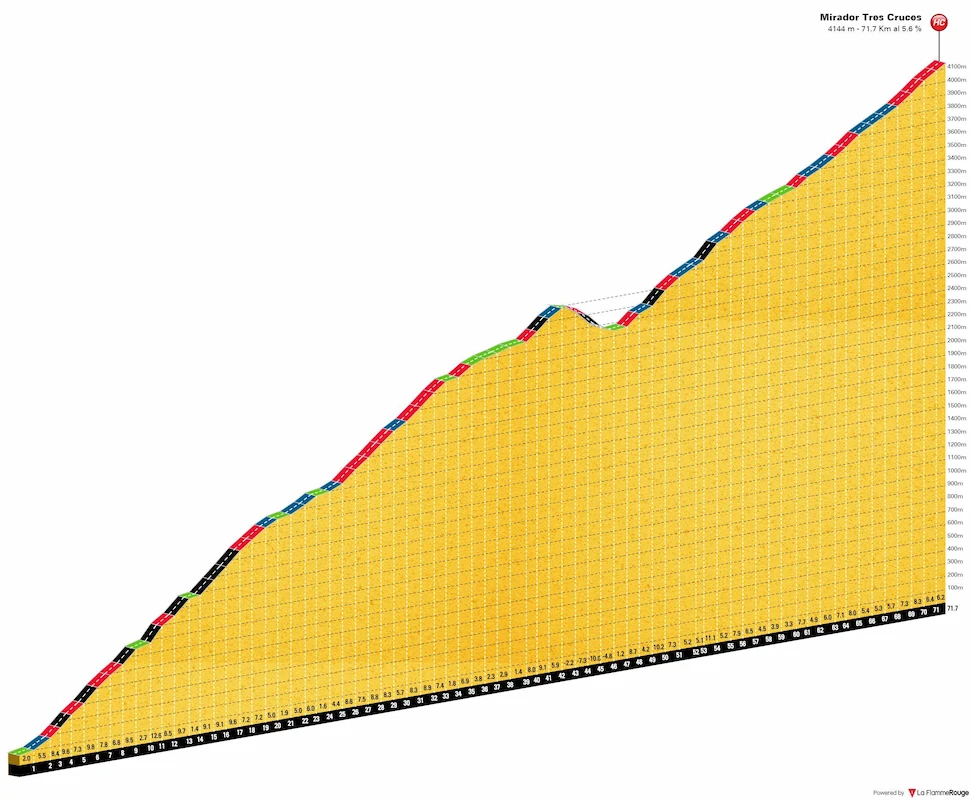
If you have ever wondered why Comobians are such good climbers, Mirador Tres Cruces offers the answer.
The 71.7-kilometer (44.5 mi) climb has an average gradient of only 5.6%, which is reduced considerably by a 5-kilometer (3 mi) descent in between. The gradient of the ascent is much steeper, especially in the first part.
Another unique feature of the climb is that it starts only 100 meters (328 ft) above sea level and ends at an altitude of 4,144 meters (13,595 ft).
17. Alto de Cordova – Peru
Length: 44.8 km (27.8 mi)
Gradient: 6.2%

South America has rugged and steep terrain. Peru’s Alto de Cordova is a testament to this.
It is a 44.8-kilometer climb (27.8 mi) that does not have a very high average gradient but contains an extremely steep intermediate section. The road stands upright for nine kilometers (5 mi) and maintains an average gradient of 13%, with three kilometers (2 mi) reaching an average gradient of 20%.
16. Hehuanshan Peak (from Fushoushan) – Taiwan
Length: 24.5 km (15.2 mi)
Gradient: 9.9%
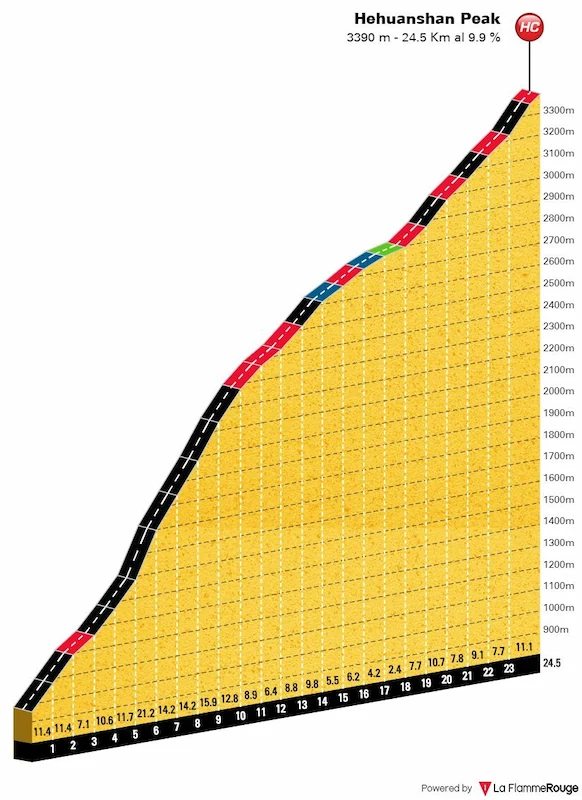
A slightly shorter climb than its predecessors but boasts a much higher average gradient.
The first half of the climb is particularly demanding, with gradients exceeding 21% at times, but the average remains at 13%. Just below the top, the road becomes upright again, but the gradient reaches “only” 11 percent this time.
15. Minas Casapalca – Peru
Length: 148.7 km (92.4 mi)
Gradient: 3.4%
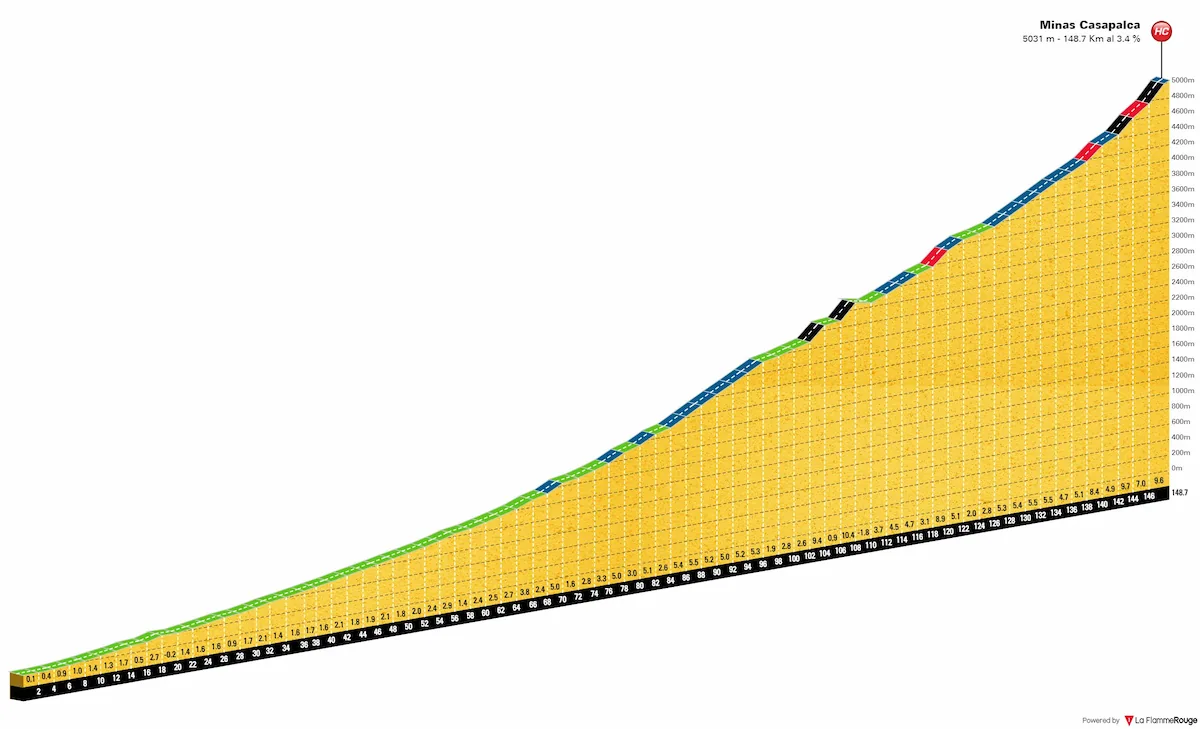
The difficulty of Minas Casapalca is not in the gradient, which is only 3.4%. What increases its difficulty coefficient is the exceptional length of the climb.
The road rises exponentially over the 148 kilometers (92 mi) of the climb. The first part is pretty much flat, with a gradient of only about 2%, and then the gradient starts to rise to about 5%, with two short sections in between where it exceeds 10%.
14. Bihan Pass – Saudi Arabia
Length: 12.5 km (7.7 mi)
Gradient: 14.3%
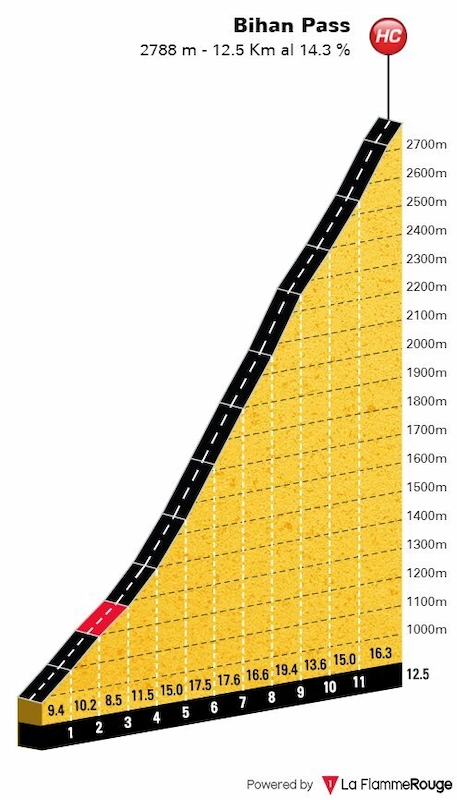
Short but sweet. The Bihan Pass is one of the shortest climbs on the list but also one of the steepest.
The 12.5 kilometers (7.7 mi) of the climb have an average gradient of less than 10% in just two kilometers and reach almost 20% in the steepest parts. The climb is made even more difficult by the fact that it lies in an area where temperatures do not drop below 20 degrees Celsius (68°F) and exceed 30 degrees Celsius (86°F) in the hottest months.
13. Ticlio – Peru
Length: 131.8 km (81.9 mi)
Gradient: 3.7%

The Ticlio climb is another in a series of extremely long, gentle climbs.
The first part is the same as the Minas Casapalca climb, but in the last few kilometers, the road turns and continues towards the top of the Ticlio instead of Minas Casaplanca. There, the most difficult part awaits the cyclist when the road climbs gradients of around 10% for four kilometers (2.5 mi).
12. Hehuanshan Peak (from Xincheng) – Taiwan
Length: 60.5 km (37.6 mi)
Gradient: 4.2%
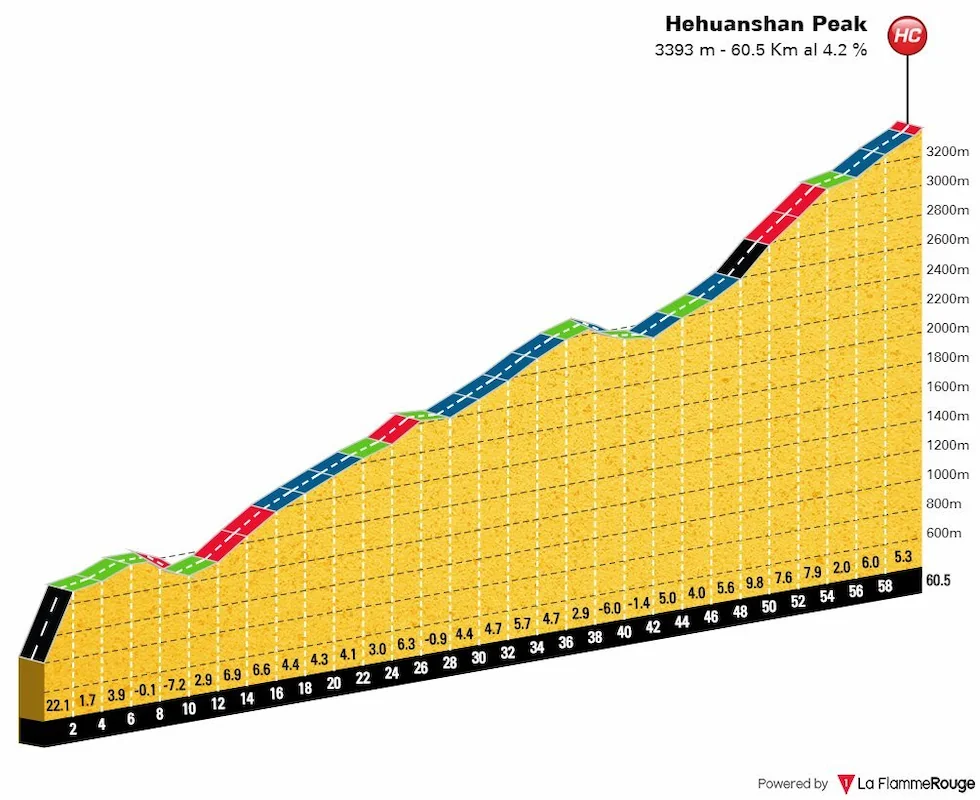
The most difficult part of the Hehuanshan Peak climb is the first two kilometers, with a staggering 22% gradient. The road then flattens out considerably and even turns downhill in some sections.
At the end, there is another difficult section, on which the cyclist crosses an altitude of 3,000 meters (9,850 ft). The finish is almost 400 meters (1,300 ft) higher.
11. Abra del Negro Bueno – Peru
Length: 160.4 km (99.6 mi)
Gradient: 2.7%

Most of Peru’s climbs are extremely long but steep. The Abra del Negro Bueno follows this pattern, covering 160 kilometers (99 mi) but with an average gradient of only 2.7%.
There are only two steeper sections on the whole climb, but these do not drastically change the difficulty of the climb. It is primarily the extreme length of the climb that is responsible for this, which takes the cyclist from an altitude of 400 meters (1300 ft) to 4,718 meters (15,479 ft) above sea level.
10. Al Ushayr – Saudi Arabia
Length: 8.8 km (5.4 mi)
Gradient: 16.9%
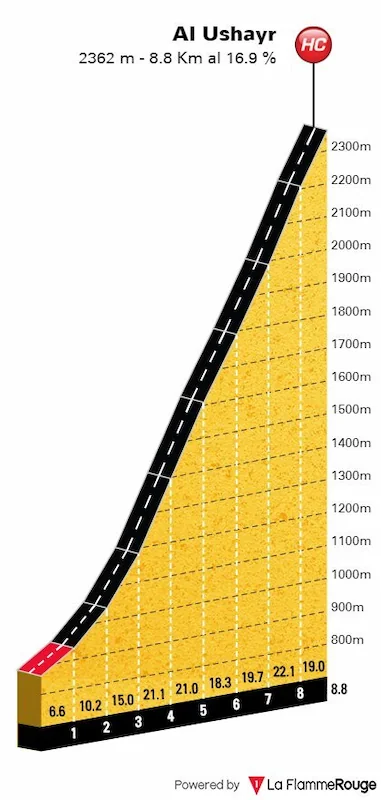
Saudi Arabia offers some of the steepest climbs in the world. Al Ushayr is certainly one of them, offering just under 9 kilometers (5.4 mi) of pure hell.
The first kilometer is not innocent, but it seems childishly easy compared to the rest of the climb. The road rises well over 15% as it goes on, and for most of the uphill section, the gradient is even around 20%.
9. Mauna Kea (from Hilo) – Hawaii (USA)
Length: 68.3 km (42.4 mi)
Gradient: 6.1%

Mauna Kea is an interesting climb that consists of two parts.
The first half is flatter and has only a few sections with steeper gradients. However, despite the lower gradient, the first part of the climb is 50 kilometers (31 mi) long, so the rider will be pretty tired by the time he reaches the more challenging second part.
The road stands upright for 18 kilometers (11 mi) there and the gradient stays above 10% for the most part. Altitude makes everything even more difficult, as the ascent ends at 4,194 meters (13,760 ft).
8. Mauna Kea (from Waikoloa) – Hawaii (USA)
Length: 84.9 km (52.7 mi)
Gradient: 4.9%
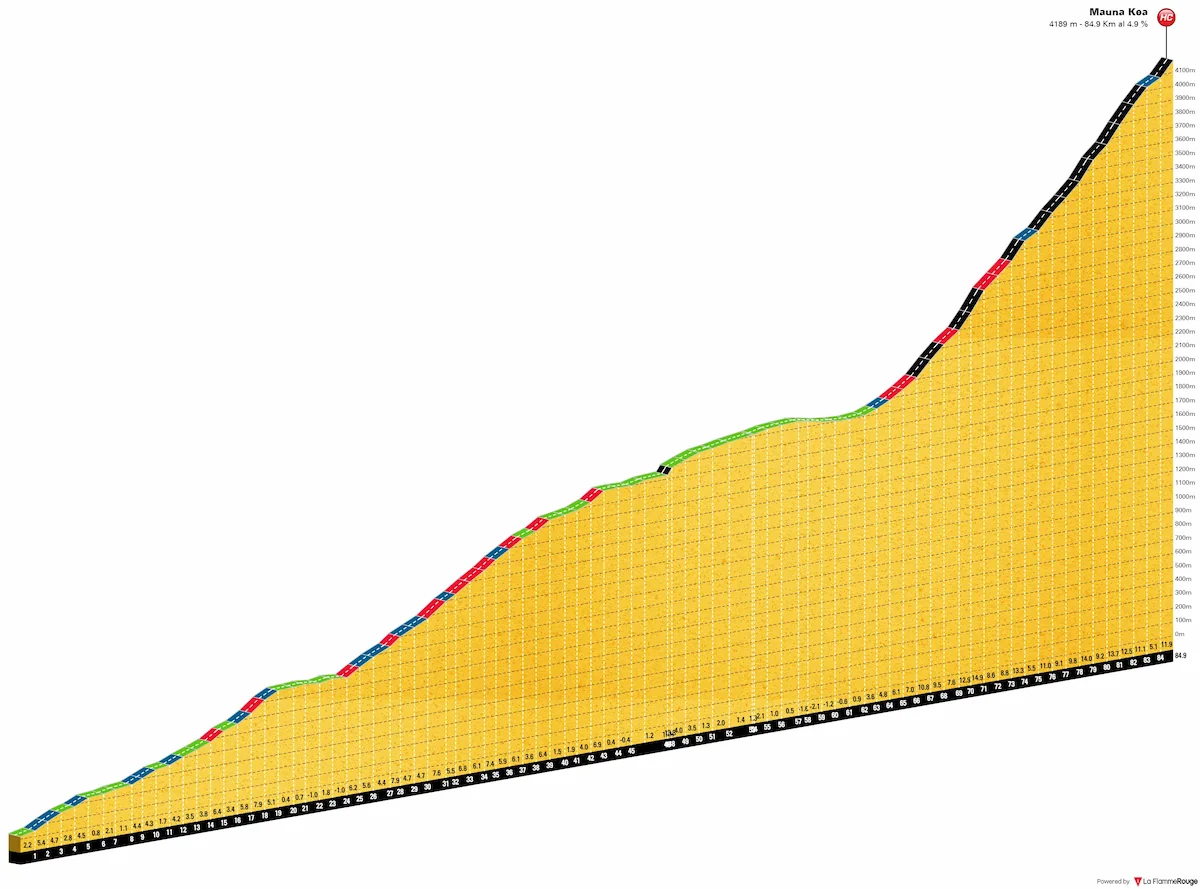
Hawaii’s most famous volcano can also be reached from the other side. The route to the summit from Waikoloa is much longer than from Hilo, but it’s also flatter.
The main difference is the much longer, flatter first part, which lowers the average gradient of the whole climb.
In the second part, the climb is the same as from Hilo. So for the last 18 kilometers (11 mi), the cyclist is again faced with a steep slope, which takes him above 4000 meters (13,000 ft) above sea level.
7. Col de l’Herpie (from Le Bourg d’Oisans) – France
Length: 27.9 km (17.3 mi)
Gradient: 8.2%
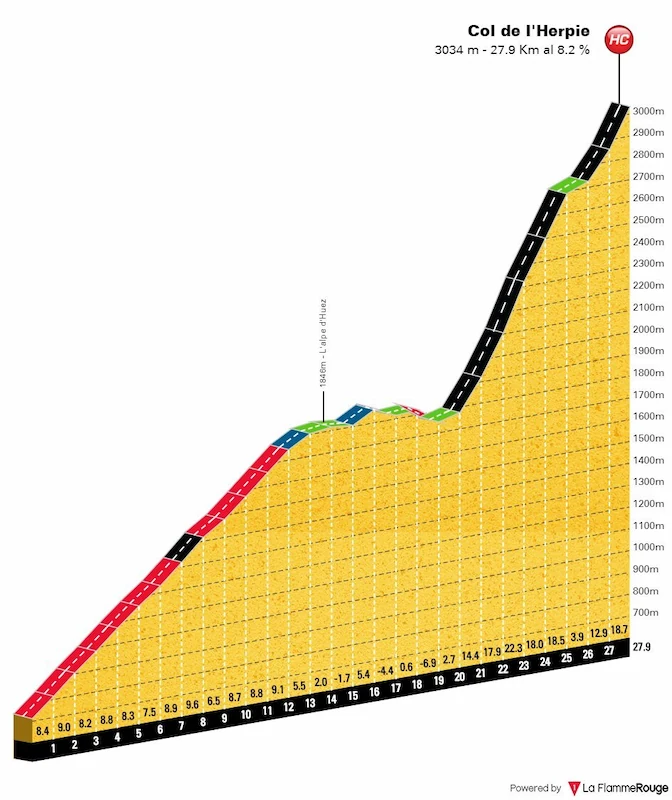
France offers many legendary climbs, most of which were made famous by the Tour de France. The Alpe d’Huez is certainly one of them, but during the ascent to the Col de l’Herpie, it is only a warm-up.
A cyclist who wants to conquer the pass under the Sarenne glacier must first climb the Alpe d’Huez and then, after a few kilometers of flat terrain, continue the journey to the top via hellish slopes, where the gradient constantly varies between 15 and 20 percent.
6. Col de l’Herpie (from La Clapier) – France
Length: 31.6 km (19.6 mi)
Gradient: 7.3%

Col de l’Herpie can also be reached without climbing the Alpe d’Huez. But don’t expect the climb to be any easier.
In the first part, a slightly longer and less even climb leads to the Sarenne Pass. Then there is a two-kilometer (1.2 mi) descent before the road becomes completely upright in the last 7.5 kilometers.
5. Pico del Teide – Canary Islands (Spain)
Length: 25.2 km (15.6 mi)
Gradient: 10.8%
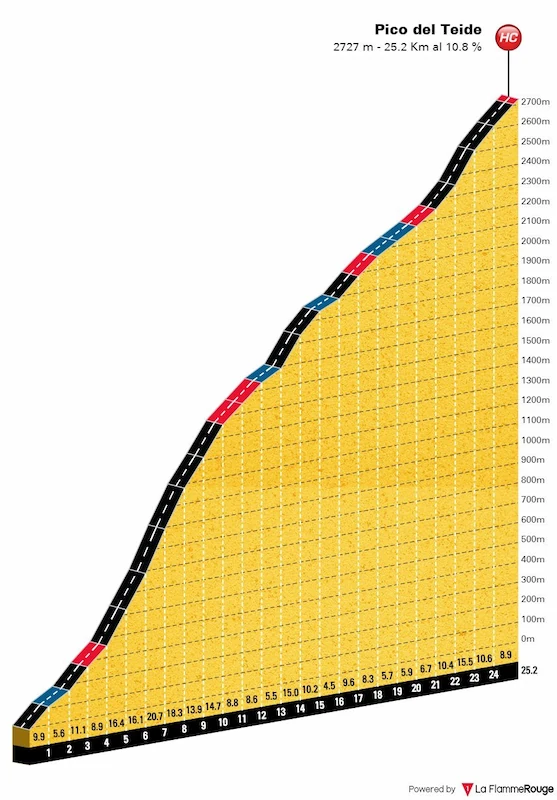
The Pico del Teide is one of the most popular climbs for professional cyclists. Winter training is often done in the Canary Islands, where they regularly tackle the slopes of the Teide volcano.
It is 25 kilometers (15.6 mi) long and rises at an average gradient of almost 11%. There is almost no easy section on the climb, while plenty of extremely difficult parts exist.
4. Boca de Tigre – Venezuela
Length: 11.8 km (7.3 mi)
Gradient: 15.9%
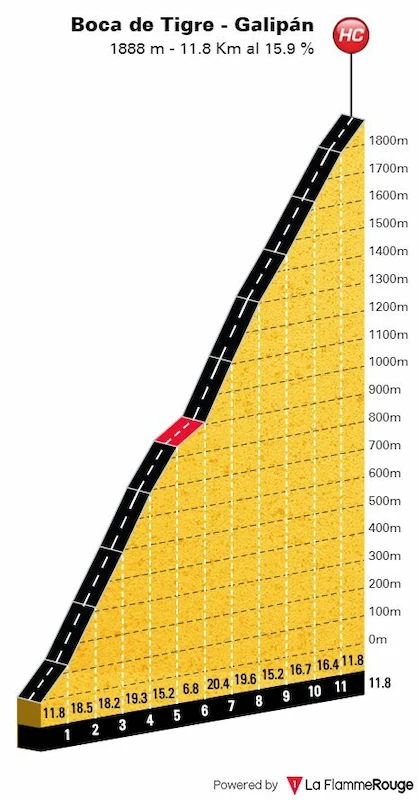
On just under 12 kilometers (7.3 mi) of Venezuelan climb, the gradient drops below 10% only once. This part comes halfway up the climb when the cyclist has already suffered five kilometers (3 mi) and still has six kilometers (4 mi) of hell to go.
The steepest part is the part after the “break”. There, the road reaches an average gradient of almost 20% for one kilometer (0.6 mi).
3. El Pichacho de Galipan – Venezuela
Length: 14.3 km (8.8 mi)
Gradient: 14.5%
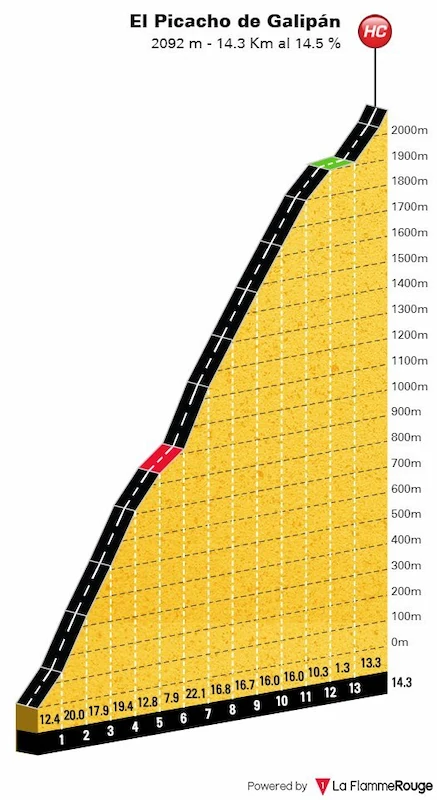
If climbing up to Boca de Tigre is not enough, you can make your trip a little longer.
Upon arrival at the pass, instead of heading downhill, head towards the summit of El Pichacha de Galipan, which is reached by another 2.5 kilometers (1.5 mi) of climbing. The first additional kilometer is flat, and then the steep finish begins, where the road reaches a gradient of 13.3 percent.
2. Mana Pass – India
Length: 86.8 km (53.9 mi)
Gradient: 4.9%
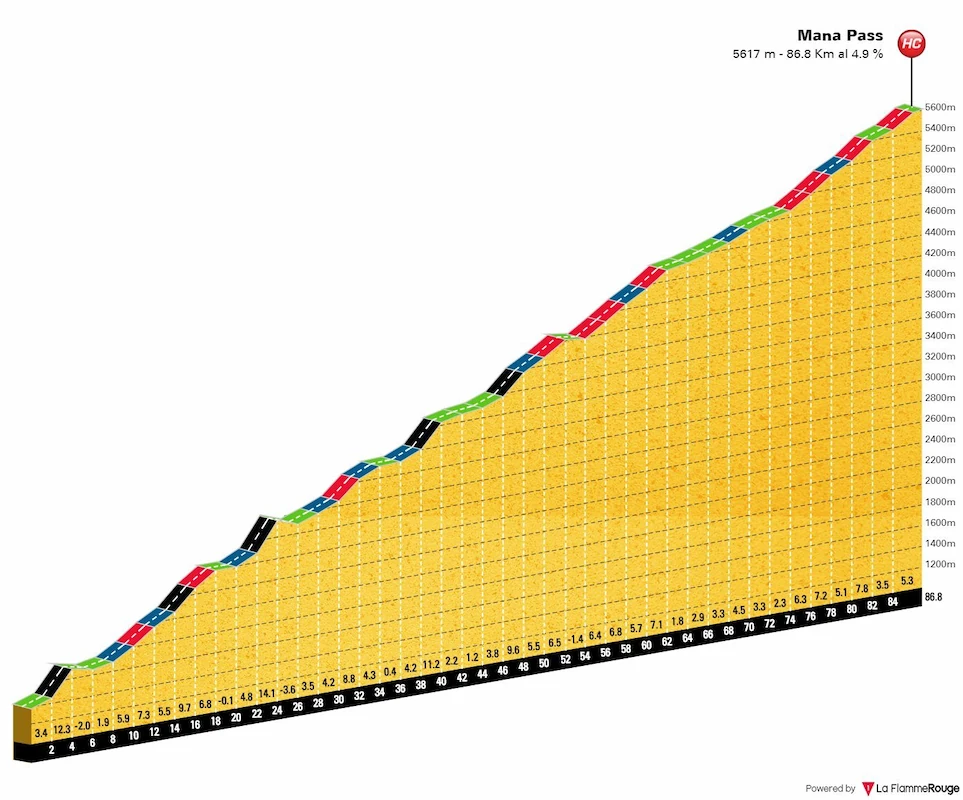
Just below the top of the ranking, we find another extremely long climb. It’s a climb that, like all long climbs, doesn’t have an extremely high average gradient, but even a 4.9% gradient seems hellish after 86 kilometers (53 mi).
The harder sections come in the first half of the climb, where the road exceeds a 10% gradient a few times. It then flattens out considerably towards the end and continues at a steady gradient to the summit, set 5,617 meters (18,428 ft) above sea level, where the air is already very thin.
1. Pozza San Glisente (from Esine) – Italy
Length: 9.3 km (5.8 mi)
Gradient: 19.7%
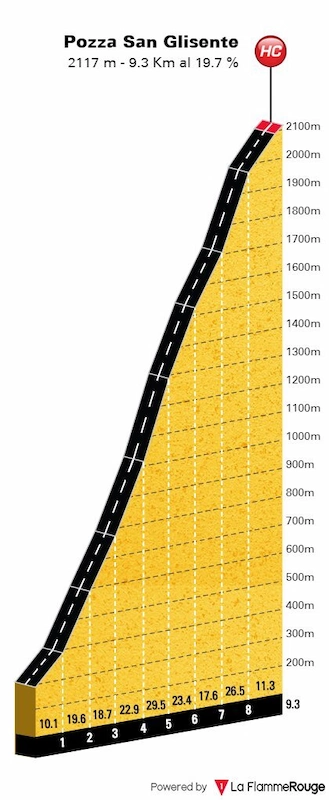
The world’s most difficult climb lies in northern Italy. It may be one of the shorter climbs on the list, but the difficulty is primarily due to the inhuman gradient. It averages an eye-watering 19.7%, and at the steepest central part, the road maintains an average gradient of 29.5% for the entire kilometer. The maximum gradient reaches an incredible 45%.
The fact that the record time of the ascent is one hour and 24 minutes speaks vividly about how demanding the climb is.

